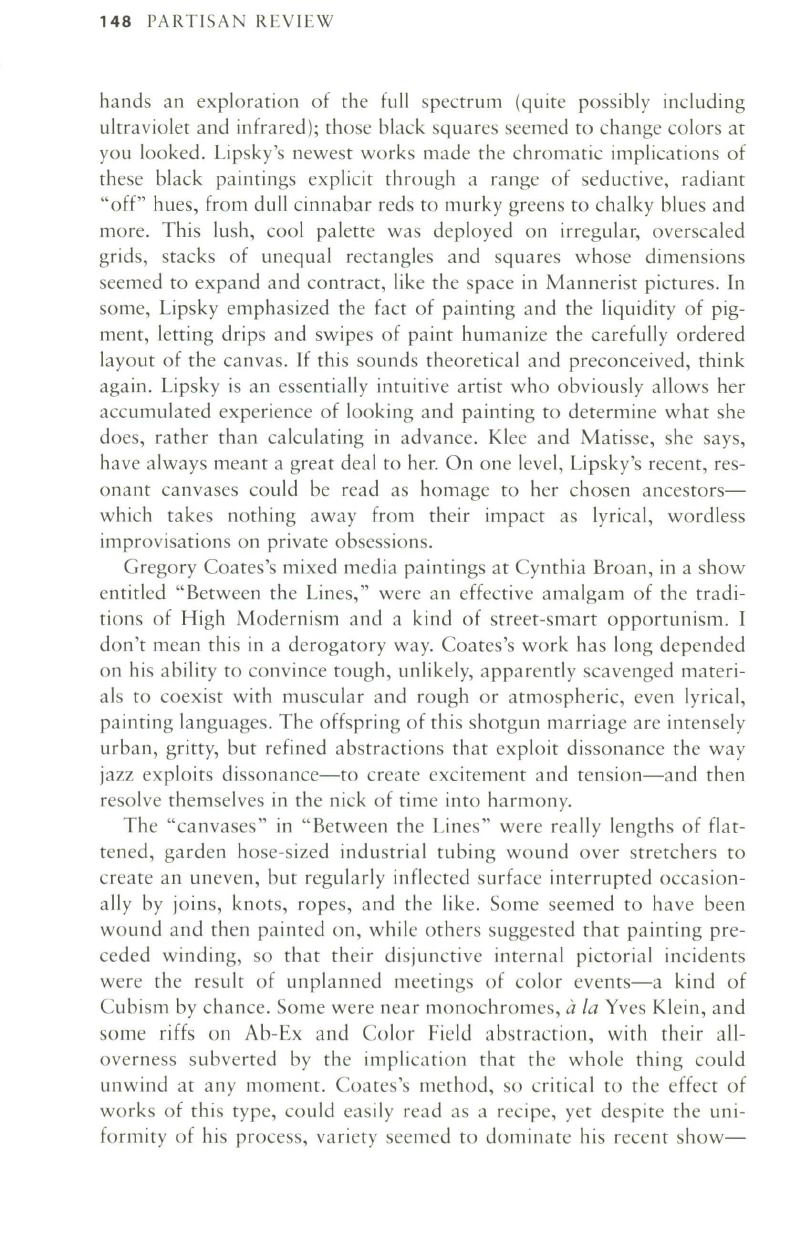
148
PARTISAN REVIEW
hands an exploration of the
full
spectrum (quite possibly including
ultraviolet and infrared); those black squares seemed to change colors at
you looked. Lipsky's newest works made the chromatic implications of
these black paintings explicit through a range of seductive, radiant
"off" hues, from dull cinnabar reds to murky greens to chalky blues and
more. This lush, cool palette was deployed on irregular, overscaled
grids, stacks of unequal rectangles and squares whose dimensions
seemed to expand and contract, like the space in Mannerist pictures.
In
some, Lipsky emphasized the fact of painting and the liquidity of pig–
ment, letting drips and swipes of paint humanize the carefully ordered
layout of the canvas.
If
this sounds theoretical and preconceived, think
again. Lipsky is an essentially intuitive artist who obviously allows her
accumulated experience of looking and painting to determine what she
does, rather than calculating in advance. Klee and Matisse, she says,
have always meant a great deal to her. On one level, Lipsky's recent, res–
onant canvases could be read as homage to her chosen ancestors–
which takes nothing away from their impact as lyrical, wordless
improvisations on private obsessions.
Gregory Coates's mixed media paintings at Cynthia Broan, in a show
entitled "Between the Lines," were an effective amalgam of the tradi–
tions of High Modernism and a kind of street-smart opportunism. I
don't mean this in a derogatory way. Coates's work has long depended
on his ability to convince tough, unlikely, apparently scavenged materi–
als to coexist with muscular and rough or atmospheric, even lyrical,
painting languages. The offspring of this shotgun marriage are intensely
urban, gritty, but refined abstractions that exploit dissonance the way
jazz exploits dissonance-to create excitement and tension-and then
resolve themselves in the nick of time into harmony.
The "canvases" in "Between the Lines" were really lengths of flat–
tened, garden hose-sized industrial tubing wound over stretchers to
create an uneven, but regularly inflected surface interrupted occasion–
ally by joins, knots, ropes, and the like. Some seemed to have been
wound and then painted on, while others suggested that painting pre–
ceded winding, so that their disjunctive internal pictorial incidents
were the resu lt of unplanned meetings of color events-a kind of
Cubism by chance. Some were near monochromes,
a
ta
Yves Klein, and
some riffs
011
Ab-Ex and Color Field abstraction, with their all–
overness subverted by the implication that the whole thing could
ullwind at any moment. Coates's method, so critical to the effect of
works of this type, could easily read as a recipe, yet despite the uni–
formity of his process, variety seemed to dominate his recent show-


